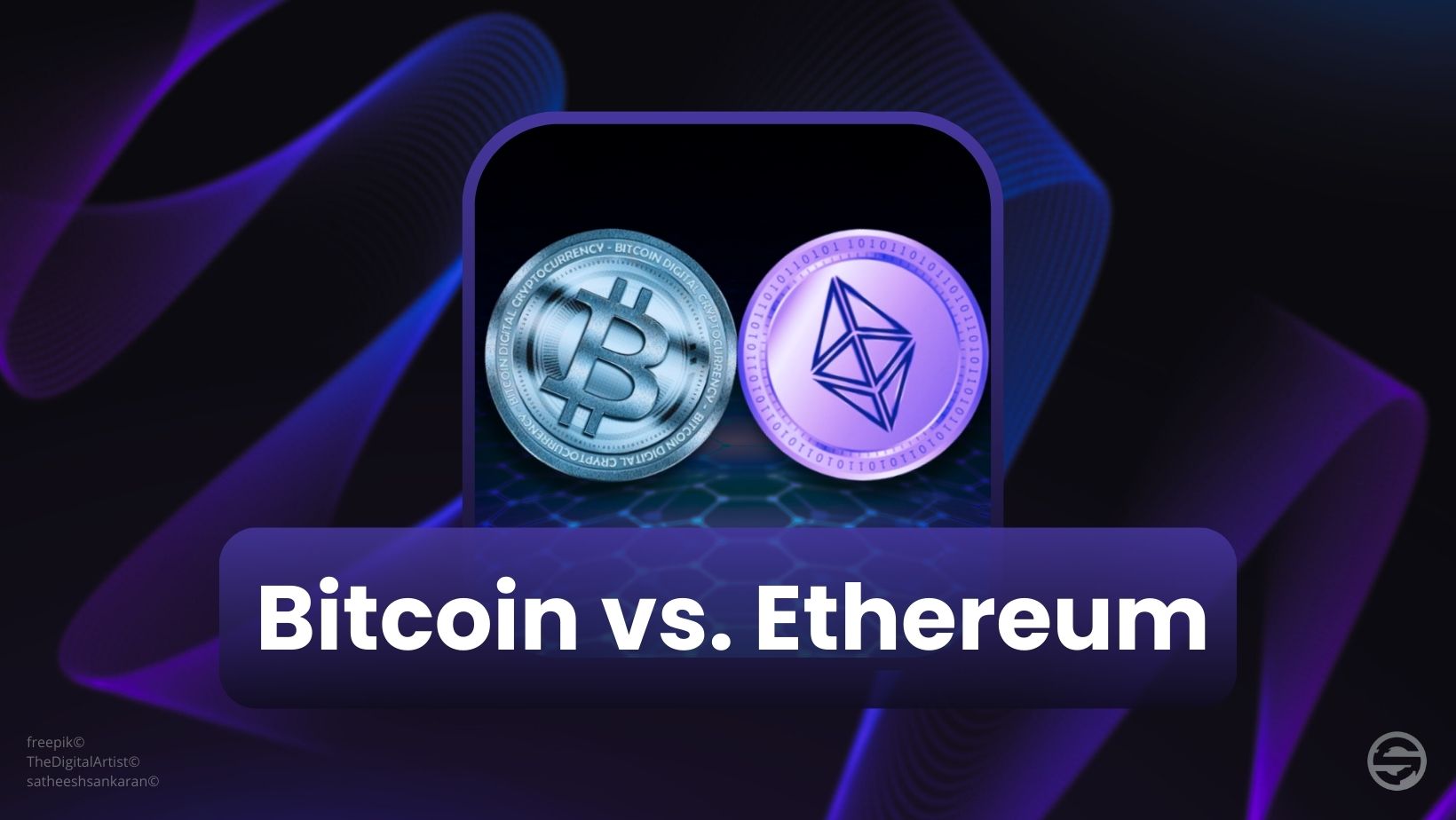
Table of contents
Bitcoin

Bitcoin was launched in January 2009 by Satoshi Nakamoto. Presented as an alternative to traditional currencies, Bitcoin operates on a decentralized basis, free from any central authority. Initially designed to provide a means of transferring value in a decentralized way, Bitcoin retains these characteristics today and is widely used as a means of exchanging and storing value. An important aspect is its limited supply, set at 21 million coins, unlike fiat currencies which have no supply limit. Moreover, the volatility of its price makes it a subject of speculation on the cryptocurrency market. Finally, Bitcoin has remained an attractive choice for investors and blockchain technology enthusiasts for over a decade. To find out more about Bitcoin, read our article: Understanding Bitcoin.
Ethereum

- Ethereum stands out as one of the leading cryptocurrencies and blockchain. Conceived by Vitalik Buterin in 2015, Ethereum is more than a cryptocurrency. Ethereum can be understood as a platform that offers a wide range of functionalities, including the creation and execution of smart contracts as well as the development of decentralized applications (DApps), without approval or the need for intermediaries. While its use also extends to trading on exchange platforms, investment, and the settlement of goods and services, Ethereum is, above all, a programmable blockchain that offers developers the possibility of using its infrastructure to create their own projects, a feature absent from Bitcoin. To find out more about Ethereum, read our article: Ethereum: the blockchain transforming the future of decentralized technology.
Different purposes

- The most significant difference between Bitcoin and Ethereum lies in their purposes.
On the one hand, Bitcoin was created as an alternative to traditional money. It aims to provide a decentralized, secure payment system, enabling users to carry out peer-to-peer (P2P) transactions without the intervention of a central authority such as a bank or government. Today, Bitcoin is also considered a digital store of value, similar to gold.
On the other hand, and as mentioned above, Ethereum was designed to be a blockchain enabling the creation and execution of smart contracts. Ethereum offers a decentralized environment in which developers can create decentralized applications. Ethereum uses its own cryptocurrency called Ether (ETH) to power these applications and execute smart contracts.

- Finally, unlike Bitcoin and its decentralized value transfer system, Ethereum aims to revolutionize industries by enabling decentralized applications and smart contracts.
Divergent underlying technologies

Bitcoin and Ethereum use different underlying technologies to achieve their respective goals.
Bitcoin uses a technology called blockchain, which is a decentralized public register of all transactions carried out on the network. Bitcoin, in blockchain terms, is designed to be immutable and secure, guaranteeing the integrity of transactions. Miners play an essential role in validating transactions and securing the Bitcoin network. Moreover, it operates using a consensus mechanism based on Proof of Work (PoW), requiring significant computing power to validate transactions and extract data.
- On the other hand, Ethereum also uses a blockchain, but with a slightly different approach. Ethereum uses a programmable blockchain, which means that developers can write code to create smart contracts and decentralized applications. This feature makes Ethereum more flexible and enables a wider variety of uses than Bitcoin. What's more, although initially designed to work with the PoW consensus mechanism, Ethereum later migrated to the Proof of Stake (PoS) consensus mechanism, offering more efficient use of energy and calling on other algorithms to maintain the network.
Diversity within supply limits

Another key difference between Bitcoin and Ethereum lies in their total supply limits;
- Bitcoin has a limited supply of 21 million coins. This means that there will never be more than 21 million Bitcoins in circulation. This set supply limit supports the idea that Bitcoin possesses properties similar to those of a store of value, such as scarcity and preservation of value over time. This limitation on the supply of Bitcoin could have an influence on Bitcoin's value over the long term. In other words, this characteristic could play a role in determining Bitcoin's future value as a digital store of value.
Since its major update called "The Merge", Ethereum has gone from PoW to PoS. Unlike Bitcoin, Ethereum has no fixed offer limit. Instead, Ethereum uses a PoS-based token issuance system, where ETH holders can lock in their holdings as "stake" to participate in the transaction validation process on the Ethereum network. In theory, an unlimited amount of Ether can be created, as there is no cap on the total number of tokens that can be issued.
Dissimilarity of their use cases

Bitcoin is primarily used as a form of digital money, often seen as the equivalent of "digital gold" due to its store-of-value function and ability to protect against the volatility of conventional financial markets. Its dominant use focuses, as mentioned above, on monetary transactions and the preservation of value.
For its part, Ethereum offers a wider range of use cases thanks to its integration of smart contracts. These decentralized contracts are the very essence of the DeFi (Decentralized Finance) movement, aimed at replicating traditional financial systems without the need for trusted third parties. In addition, Ethereum is the preferred playground for most non-fungible tokens (NFTs), which represent unique digital assets ranging from digital art to virtual real estate, and are used to attest ownership or authenticity. Other applications include Decentralized Autonomous Organizations (DAOs), supply chain management and many more.
Comparing scalability

- Due to its Proof of Work (PoW) consensus mechanism, Bitcoin's scalability is limited, resulting in a processing capacity of only 7 to 8 transactions per second.This restriction hampers the network's efficiency in processing large volumes of transactions, which can affect its ease of use and widespread adoption.
Although Ethereum shows better scalability than Bitcoin, with the ability to process around 30 transactions per second, this blockchain also faces scalability challenges.
However, Ethereum is actively working to improve its scalability as part of its Ethereum 2.0 upgrade, which is being rolled out in several phases.

Conclusion
In conclusion, Bitcoin and Ethereum are two major cryptocurrencies that differ in their purposes, underlying technology, offering limits, use cases and scalability. Bitcoin focuses primarily on decentralized financial transactions, while Ethereum offers a decentralized environment for the development of smart contracts and applications.
- Sources:
- https://www.bitcoin.com/get-started/difference-between-bitcoin-and-ethereum/, consulted on 01.04.24
- https://cryptomus.com/blog/what-is-the-difference-between-bitcoin-and-ethereum, consulted on 0104.24
- Disclaimer: this is not financial advice. Satolix.io website aims to inform readers about Blockchain, cryptocurrencies and Web3. Any type of investment involves risk. Please do your due diligence and research the articles and projects presented on the site. Be responsible and don't invest more than your goals or financial means allow. In this regard, please read our page: Warning about virtual currencies.
- Some articles on the site contain affiliate links, and using them to register on the site enables the site to grow through the collection of commissions. By doing so, you also make yourself eligible for a welcome bonus such as a voucher or reduced fees, for example.



 Blockchain
Blockchain 2024-04-03
2024-04-03
